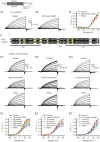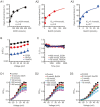The residue I257 at S4-S5 linker in KCNQ1 determines KCNQ1/KCNE1 channel sensitivity to 1-alkanols
- PMID: 26725740
- PMCID: PMC4722973
- DOI: 10.1038/aps.2015.133
The residue I257 at S4-S5 linker in KCNQ1 determines KCNQ1/KCNE1 channel sensitivity to 1-alkanols
Abstract
Aim: KCNQ1 and KCNE1 form a complex in human ventricular cardiomyocytes, which are important in maintaining a normal heart rhythm. In the present study we investigated the effects of a homologous series of 1-alkanols on KCNQ1/KCNE1 channels expressed in Xenopus oocytes.
Methods: ECG recording was made in rats injected with ethanol-containing solution (0.3 mL, ip). Human KCNQ1 channel and its auxiliary subunit KCNE1 were heterologously coexpressed in Xenopus oocytes, which were superfused with ND96 solution; 1-alkanols (ethanol, 1-butanol and 1-hexanol) were delivered through a gravity-driven perfusion device. The slow-delayed rectifier potassium currents IKs (KCNQ1/KCNE1 currents) were recorded using a two-electrode voltage clamp method. Site-directed mutations (I257A) were made in KCNQ1.
Results: In ECG recordings, a low concentration of ethanol (3%, v/v) slightly increased the heart rate of rats, whereas the higher concentrations of ethanol (10%, 50%, v/v) markedly reduced it. In oocytes coexpressing KCNQ1/KCNE1 channels, ethanol, 1-butanol and 1-hexanol dose-dependently inhibited IKs currents with IC50 values of 80, 11 and 2.7 mmol/L, respectively. Furthermore, the 1-alkanols blocked the KCNQ1 channel in both open and closed states, and a four-state model could adequately explain the effects of 1-alkanols on the closed-state channel block. Moreover, the mutation of I257A at the intracellular loop between S4 and S5 in KCNQ1 greatly decreased the sensitivity to 1-alkanols; and the IC50 values of ethanol, 1-butanol and 1-hexanol were increased to 634, 414 and 7.4 mmol/L, respectively. The mutation also caused the ablation of closed-state channel block.
Conclusion: These findings provide new insight into the intricate mechanisms of the blocking effects of ethanol on the KCNQ1 channel.
Figures





Similar articles
-
Dysfunctional potassium channel subunit interaction as a novel mechanism of long QT syndrome.Heart Rhythm. 2013 May;10(5):728-37. doi: 10.1016/j.hrthm.2012.12.033. Epub 2013 Jan 2. Heart Rhythm. 2013. PMID: 23291057 Free PMC article.
-
Ginsenoside Rg3 activates human KCNQ1 K+ channel currents through interacting with the K318 and V319 residues: a role of KCNE1 subunit.Eur J Pharmacol. 2010 Jul 10;637(1-3):138-47. doi: 10.1016/j.ejphar.2010.04.001. Epub 2010 Apr 21. Eur J Pharmacol. 2010. PMID: 20399767
-
KCNE1 and KCNE3 stabilize and/or slow voltage sensing S4 segment of KCNQ1 channel.J Gen Physiol. 2007 Sep;130(3):269-81. doi: 10.1085/jgp.200709805. Epub 2007 Aug 13. J Gen Physiol. 2007. PMID: 17698596 Free PMC article.
-
Insights into Cardiac IKs (KCNQ1/KCNE1) Channels Regulation.Int J Mol Sci. 2020 Dec 11;21(24):9440. doi: 10.3390/ijms21249440. Int J Mol Sci. 2020. PMID: 33322401 Free PMC article. Review.
-
KCNE1 and KCNE3: The yin and yang of voltage-gated K(+) channel regulation.Gene. 2016 Jan 15;576(1 Pt 1):1-13. doi: 10.1016/j.gene.2015.09.059. Epub 2015 Sep 26. Gene. 2016. PMID: 26410412 Free PMC article. Review.
Cited by
-
Ion channels research in the post-genomic era.Acta Pharmacol Sin. 2016 Jan;37(1):1-3. doi: 10.1038/aps.2015.144. Acta Pharmacol Sin. 2016. PMID: 26725731 Free PMC article. No abstract available.
-
Electrophysiological characterization of human KCNT1 channel modulators and the therapeutic potential of hydroquinine and tipepidine in KCNT1 mutation-associated epilepsy mouse model.Acta Pharmacol Sin. 2025 May;46(5):1190-1204. doi: 10.1038/s41401-024-01457-8. Epub 2025 Jan 27. Acta Pharmacol Sin. 2025. PMID: 39870847
References
-
- 1Dopico AM, Anantharam V, Treistman SN. Ethanol increases the activity of Ca2+-dependent K+ (mslo) channels: functional interaction with cytosolic Ca2+. J Pharmacol Exp Ther 1998; 284: 258–68. - PubMed
-
- 2Lewohl JM, Wilson WR, Mayfield RD, Brozowski SJ, Morrisett RA, Harris RA. G-protein-coupled inwardly rectifying potassium channels are targets of alcohol action. Nat Neurosci 1999; 2: 1084–90. - PubMed
-
- 3Moore MS, Dezazzo J, Luk AY, Tully T, Signh CM, Heberlein U. Ethanol intoxication in Drosophila: Genetic and pharmacological evidence for regulation by the cAMP signaling pathway. Cell 1998; 93: 997–1007. - PubMed
-
- 4Deitrich RA, Dunwiddie TV, Harris RA, Erwin VG. Mechanism of action of ethanol: initial central nervous system actions. Pharmacol Rev 1989; 41: 489–537. - PubMed
-
- 5Homanics GE, Xu Y, Tang P. Integrated approaches to the action of general anesthetics and alcohol. Physiol Behav 2002; 77: 495–9. - PubMed
Publication types
MeSH terms
Substances
LinkOut - more resources
Full Text Sources
Other Literature Sources

